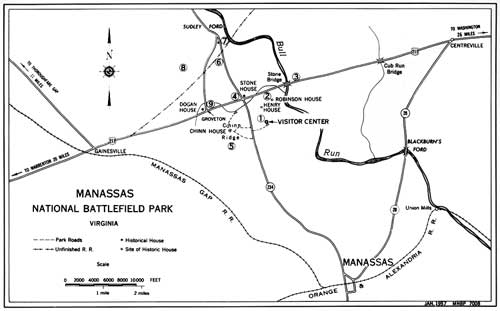|
MANASSAS National Battlefield Park |
 |

(click on map for a larger image)
Guide to the Area (see map above)
This guide has been prepared to enable you to identify and appreciate the chief points of historical interest on the two battlefields. While there are other locations of importance on park property and on privately owned adjacent lands, those listed below may be considered the most conspicuous.
Wherever an area, such as Henry Hill and Chinn Ridge, featured prominently in both battles, its story has been told jointly, rather than separately. This has been done in order to avoid unnecessary backtracking. It should be observed that the numbers 1 to 9 have been located on a tour map for your convenience.

Looking west across Henry Hill to the Visitor
Center. The Jackson Monument is shown in the left foreground.
For the purposes of orientation a visit to the museum should precede a tour of the fields.
1. HENRY HILL. Covering an area of approximately 200 acres, the top of this plateau embraces parts of the old Henry Farm and of the Robinson tract. It extends roughly northeast from the Henry woods to Lee Highway near the site of the Robinson House. Twice the hill held the key to victory. After hours of heavy fighting in the first battle, its loss to McDowell proved a significant factor in the collapse of Federal resistance, while in the second, its stubborn defense secured the retreat of Pope's Army over Bull Run.
Some of the points of special interest here include:
Visitor Center. On a commanding rise of the hill is located the Visitor Center, which represents the focal center in the interpretation of the area. From the terrace on the north and east sides of the building, a sweeping panoramic view may be had of the valley of Young's Branch and the hills beyond which constitute the chief scenes of tactical maneuver of the two battles.
Jackson Monument. Located approximately 125 yards east of the Visitor Center is the equestrian statue of "Stonewall" Jackson. It was erected by the State of Virginia in 1940, reputedly on the spot where he received his famous nickname. To a large degree Jackson's character and personality dominated the fighting of both First and Second Manassas.

Diorama in the museum depicting incident when Jackson
was given the name "Stonewall."
Line of "Confederate Batteries. Just north of Jackson's statue are markers indicating the position of Confederate batteries of 26 guns which engaged the 11 guns of Ricketts' and Griffin's Federal batteries at a distance of about 330 yards. With this furious artillery duel the first battle reached its crisis. Today, cannon mark this position.
Bee Monument. South of the Jackson statue, about 100 feet, stands a white marble monument erected to the memory of Gen. Barnard E. Bee, who fell mortally wounded at this spot in the first battle. Shortly before, while desperately attempting to rally his men, Bee had won immortal fame with the stirring battle cry which gave Jackson the name of "Stonewall."
Bartow Monument. About 180 feet north of the Jackson statue is a stone block bearing a bronze tablet erected to the memory of Col. F. S. Barrow, commander of the 2d brigade of Johnston's army, who was killed in the first battle on this spot. At a critical moment in the early phase of the battle, Bee and Barrow had given Evans valiant support.
Position of Ricketts' and Griffin's Guns. Just south of the Henry House are cannon and markers indicating the advanced position occupied by the Union batteries of Ricketts and Griffin during the first battle. In a surprise attack, which practically annihilated these two gallant batteries, Ricketts was severely wounded.

View northwest across Henry Hill. The present
Henry House is seen in center background.
Henry House, About 650 feet northwest of the Visitor Center stands the Henry House which was erected shortly after the war on the site of the famous original structure. During the first battle, the original little house was caught in the line of cross artillery fire which killed its owner. Mrs. Judith Henry. Badly damaged, it suffered further mutilation during the following year. By the end of the second battle the house was a complete ruin.
Grave of Judith Henry. In the Henry yard, a few feet west of the house, is the grave of the widow, Judith Henry, enclosed by an iron railing and shrubbery. She is said to have been buried here by Confederate soldiers the day after the first battle. A son and daughter are also interred here. Mrs. Henry's tragic death is dramatically treated in Stephen Vincent Benet's poem, "John Brown's Body."
Union Monument. This pyramidal monument of reddish brown stone, located in the yard on the east side of the Henry House, was erected by Union soldiers in 1865 to the memory of their comrades who fell in the first battle. It is one of the earliest memorial monuments of the Civil War.

|

|
|
Last Modified: Sat, Apr 7 2001 10:00:00 am PDT |


